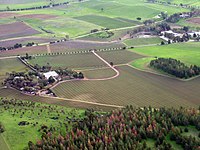
Photo from wikipedia
The networks of factor flows in rural areas are the main support for rural revitalization, which has become one of the research trends in rural geography. Taking a typical industrial… Click to show full abstract
The networks of factor flows in rural areas are the main support for rural revitalization, which has become one of the research trends in rural geography. Taking a typical industrial town in China as an example, the study explored the operating characteristics of rural factor flow networks and the relations of multi-factor flows based on the social survey method and fine-grained flows data. Results showed that population flows, capital flows and policy flows increased significantly in rural areas. Thereinto, population flows, especially labor flows, mainly ran into the townships and industrial cluster villages, so did capital inflows and outflows, while policy flows ran around the township. The villages with dense population and capital flows formed the "central villages", which had exceeded the township in the two flow networks. Policy flows and capital flows played a guiding role in population flows, so did the policy flows on the capital flows. Meanwhile, the population flows and the capital flows could reinforce each other. In conclusion, a multi-center structure network with the separation of economic center and administrative center had been formed in rural areas. And there was a close interaction between these factor flows. Furthermore, the theoretical model of town-village symbiotic network was constructed.
Journal Title: PLOS ONE
Year Published: 2023
Link to full text (if available)
Share on Social Media: Sign Up to like & get
recommendations!